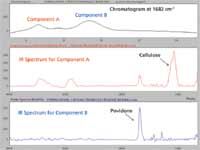Characterization of Polymeric Excipients by SEC-IR
The Application Notebook
Excipients are pharmacologically inactive substances used as carrier and release controllers for active drug ingredients. A significant amount (30–80% solid) of polymeric excipients such as hydroxyl propyl cellulose (HPC), hydroxypropyl methyl cellulose (HPMC), hydroxypropyl methyl cellulose acetate succinate (HPMCAS), and povidone are used.
Excipients are pharmacologically inactive substances used as carrier and release controllers for active drug ingredients. A significant amount (30–80% solid) of polymeric excipients such as hydroxyl propyl cellulose (HPC), hydroxypropyl methyl cellulose (HPMC), hydroxypropyl methyl cellulose acetate succinate (HPMCAS), and povidone are used. These excipients have a very large molecular weight (MW) which is not suitable for the commonly used drug QC method by LC–MS. Whereas SEC-IR is feasible of characterizing any polymeric excipients in all drug forms.
OHpak SB-806M HQ, a mixed gel type SEC column, is suitable for separating excipients and active ingredients based on their sizes. Size-separated components are then detected by IR which provides compositional fingerprinting information. The method is useful in the areas such as excipient incoming QC, formulation development, excipient degradation, and deformulation.
Experimental Conditions
Separation was carried out by Shodex OHpak SB-806M HQ SEC column (8.0 × 300 mm, 13 µm, 15,000 Å). Mobile phase consisted of 1.5% DMF in water and the flow rate used was 1.0 mL/min. The column was heated at 40 °C.
DiscovIR-LC (Spectra Analysis Instrument), solvent-removing direct-deposition solid phase FTIR, was used as the detector. Cyclone temperature was set at 150 o C and ZnSe disk temperature was set between -10 to -15 °C.
About 50 mg of the excipient sample was fully dissolved in 10 mL mobile phase and filtered with 0.45 mm PTFE filter before injection. Final concentration was ~0.5% (w/v) and injection volume of 100 µL was used.
Results
Components in the test sample were separated based on their sizes by SEC and simultaneously characterized by IR. SEC chromatogram (Figure 1, top) shows the presence of two components having different molecular sizes. They were further characterized by IR: The middle figure shows component A with larger MW consists of cellulose and some povidone; whereas the bottom figure shows component B having smaller MW consists of pure povidone.

Figure 1: Top: SEC chromatogram showing the presence of two components with different MW distributions. Middle: IR spectrum for larger MW component. Bottom: IR spectrum for smaller MW component.
Recommended mobile phase depends on the excipient type. Water with 1.5% DMF is suitable for HPC, HPMC, and povidone. While H2O/CH3OH (1:1) with 0.05 M acetic acid and THF are
recommended for copovidone and HPMCAS analysis respectively.
Conclusions
SEC-IR is a powerful tool to de-formulate complex excipient mixtures in pharmaceutical formulations. Shodex OHpak SB-806M HQ is well suited to separate water-soluble polymeric excipients such as HPC, HPMC, and povidone. Separated components are detected online by DiscovIR-LC which provide chemical composition details across the whole SEC separation. The method offers many ways of analyzing functional group variations across MW distribution; including comonomer ratios by IR peak heights and side group to backbone ratio. This is useful to characterize lot-to-lot, grade-to-grade, and/or supplier-to-supplier variations of polymeric excipients.
Shodex™ /Showa Denko America, Inc.
420 Lexington Avenue Suite 2850, New York, NY, 10170
tel. (212) 370-0033 x109
Website: www.shodex.net
Spectra Analysis Instruments, Inc.
257 Simarano Drive, Marlborough, MA 01752
tel. (508) 281-6232
Website: www.spectra-analysis.com

SEC-MALS of Antibody Therapeutics—A Robust Method for In-Depth Sample Characterization
June 1st 2022Monoclonal antibodies (mAbs) are effective therapeutics for cancers, auto-immune diseases, viral infections, and other diseases. Recent developments in antibody therapeutics aim to add more specific binding regions (bi- and multi-specificity) to increase their effectiveness and/or to downsize the molecule to the specific binding regions (for example, scFv or Fab fragment) to achieve better penetration of the tissue. As the molecule gets more complex, the possible high and low molecular weight (H/LMW) impurities become more complex, too. In order to accurately analyze the various species, more advanced detection than ultraviolet (UV) is required to characterize a mAb sample.















